Edge of Evolution: Exploring Darwin Island’s Underwater Eden
Darwin Island, the northernmost jewel of the Galápagos, is a volcanic sentinel rising from the Pacific depths. Named in honor of Charles Darwin—though he never set foot here—this remote island is a UNESCO World Heritage Site and a magnet for advanced divers. Renowned for its collapsed Darwin’s Arch (now “Darwin’s Pillars”), thriving shark populations, and nutrient-rich currents, Darwin Island offers a primal encounter with marine biodiversity. As part of the Hermandad Marine Reserve, it safeguards migratory species like whale sharks and hammerheads, making it a cornerstone of global conservation efforts.
Darwin Island Fast Facts
- Area: 2.33 km² (0.9 sq mi), the tip of a submerged volcano.
- Elevation: 168 meters (550 ft) above sea level.
- UNESCO Protected: Part of the Galápagos World Heritage Site since 1978; no terrestrial visitor access.
- Exclusive Access: Only reachable via liveaboard diving cruises; fewer than 1,500 visitors annually.
- Iconic Feature: Darwin’s Arch (collapsed in 2021), now a submerged plateau teeming with marine life.
Darwin Island Activity Highlights
- Dive Darwin’s Pillars: Swim beneath the remnants of Darwin’s Arch, surrounded by schools of scalloped hammerheads and seasonal whale sharks (June–November).
- Snorkel with Giants: Encounter whale sharks, the largest fish in the ocean, filtering plankton near the surface.
- Birdwatch from the Boat: Spot red-footed boobies, frigatebirds, and the island’s sole breeding colony of sooty terns.
- Photograph Volcanic Drama: Capture the island’s stark cliffs and seabird colonies from zodiacs or cruise decks.
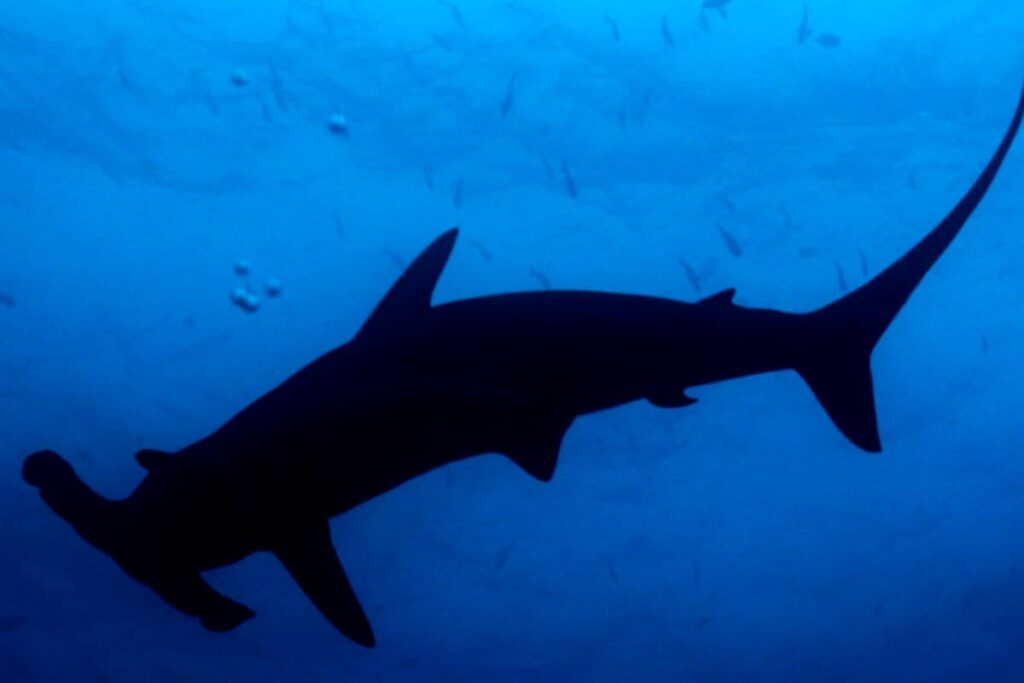
Darwin Island Animal Highlights
- Scalloped Hammerhead Sharks: Gather in hundreds at Darwin’s Pillars, forming mesmerizing vortexes.
- Whale Sharks: Juvenile giants frequent the area June–November, drawn by nutrient-rich upwellings.
- Galapagos Sharks: Patrol underwater cliffs alongside hammerheads.
- Manta Rays: Glide through currents with wingspans up to 7 meters.
- Sooty Terns: The island’s only breeding colony nests on cliffs.
- Red-Footed Boobies: Nest in shrubs, their turquoise feet contrasting against volcanic rock.
History
Volcanic Origins: Formed 400,000–1.6 million years ago, Darwin Island is part of the Wolf-Darwin volcanic ridge, a tectonic boundary between the Nazca and Cocos plates. Its iconic Darwin’s Arch collapsed in 2021 due to erosion, leaving two basaltic pillars.
Human Discovery: First charted by buccaneer Ambrose Cowley in 1684 as Culpepper Island, it was later renamed for Charles Darwin. The first confirmed landing occurred during a 1964 scientific expedition using helicopters; today, no terrestrial access is permitted to protect wildlife.
Conservation Milestones: Following rampant illegal fishing (e.g., the 2017 seizure of Chinese vessel Fu Yuan Yu Leng 999 with 7,639 sharks), Ecuador established the Hermandad Marine Reserve in 2022, safeguarding migratory routes across the Galápagos-Cocos Swimway. A floating patrol base now monitors the area.
Geography
- Location: Over 160 km (100 mi) northwest of Isabela Island, atop the Nazca Plate boundary. (about 21km north of Wolf Island)
- Geology: Composed of basaltic rock from extinct volcanoes; underwater cliffs drop 1,000 meters to the seafloor.
- Marine Features: Nutrient-rich currents attract pelagic species, creating one of the planet’s richest dive sites.
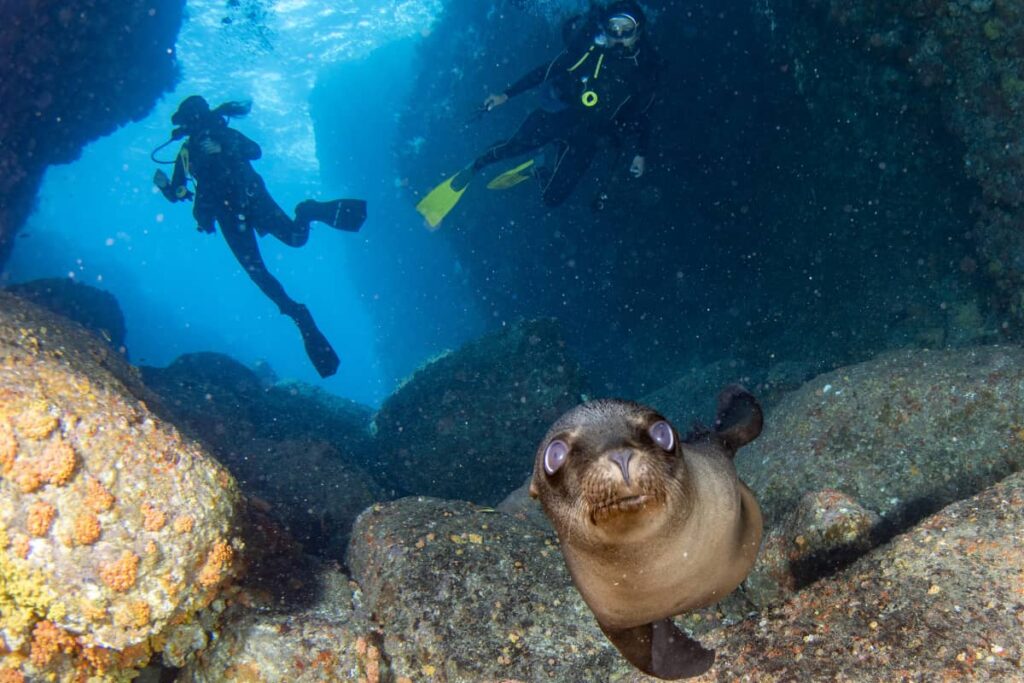
Getting to Darwin Island
- Liveaboard Cruises: The only way to visit. Operators like Royal Galapagos and Golden Galapagos offer 8–10-day itineraries with 3–4 daily dives. Click here for details!
- Private Charter: more expensive, but also has advantages. Learn more here.
- Permits Required: Managed by the Galápagos National Park; Advanced Open Water certification mandatory.
Conservation Challenges
- Illegal Fishing: Despite patrols from Wolf Island’s floating base, shark finning remains a threat, with over 1,000 sharks seized annually in regional enforcement operations (Galápagos National Park Directorate, 2023). The 2017 capture of the Chinese vessel Fu Yuan Yu Leng 999—carrying 7,639 sharks, including endangered scalloped hammerheads—exposed ties to Asian black markets).
- Climate Change: Warming seas (up 1.5°C since 1980) disrupt plankton blooms, reducing whale shark prey by 30% and altering migration patterns. This also impacts endemic species like the sooty tern, whose breeding success drops by half during El Niño events due to fish scarcity.
- Tourism Pressure: Strict visitor limits mitigate ecosystem damage, but unregulated operators risk anchor damage to reefs and plastic pollution in nesting zones.
Climate
- Dry Season (June–November): Cooler (18–24°C), strong currents, peak whale shark activity.
- Wet Season (December–May): Warmer (24–30°C), calmer seas, ideal for hammerhead encounters.
How to Visit Darwin Island
Option 1: Liveaboard Diving Cruises
Best For: Advanced divers seeking structured itineraries and marine immersion.
Pros:
- Expert Guides: Dive masters familiar with Darwin’s strong currents and pelagic life lead 3–4 daily dives, including drift dives around Darwin’s Pillars. Operators like Royal Galapagos and Golden Galapagos prioritize safety and wildlife encounters, with nitrox tanks and reef hooks provided.
- Guaranteed Permits: Only licensed liveaboards can access Darwin Island, with permits pre-arranged through the Galápagos National Park. Annual visitor limits (≤1,200 divers) ensure minimal ecosystem disruption.
- All-Inclusive Packages: Meals, gear rental, and accommodations are bundled into 8–10-day itineraries. Boats like the feature en-suite cabins and marine-focused amenities.
Cons:
- High Cost: Prices start at $6,000+ per person, exceeding most land-based tours. Budget-friendly options offer bunk-bed cabins but lack luxury amenities.
- Fixed Schedules: No terrestrial exploration is permitted, and itineraries prioritize dive sites like Darwin’s Pillars, leaving little flexibility for spontaneous wildlife encounters.
- Physical Demands: Strong currents (up to 3 knots) and negative entries from pangas (boats) require Advanced Open Water certification and 50+ logged dives.
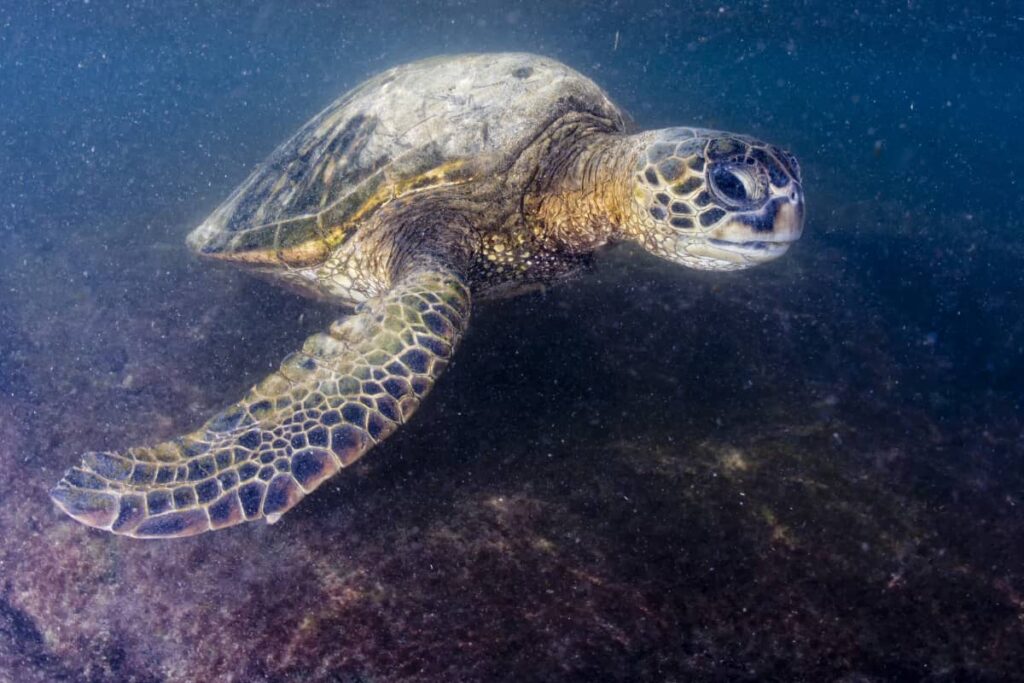
Option 2: Private Charters
Best For: Researchers, filmmakers, or small groups needing tailored access.
Pros:
- Custom Itineraries: Design dive schedules around shark migrations (e.g., tagging whale sharks June–November) or volcanic seamount studies.
- Extended Stays: Charters permit 10–14-day expeditions vs. standard 8-day liveaboards, ideal for long-term shark biomass surveys or filming seabird breeding.
- Exclusivity: Avoid crowded dive boats; ideal for photographers documenting rare species like tiger sharks or sooty tern colonies.
Cons:
- Permit Complexity: Requires 6+ months’ notice and direct negotiation with the Galápagos National Park, including proof of scientific credentials or conservation goals.
- Higher Costs: Charters cost $15,000+ for groups <10, with limited operators offering specialized vessels.
- Logistical Hurdles: Limited infrastructure (e.g., no docking facilities) means relying on pangas for transfers, which can be delayed by rough seas.
Key Considerations
- Permit Requirements: Most visitors must pay a $200 Galápagos National Park fee and adhere to strict no-anchor zones to protect reefs.
Activities & Experiences
- Diving the Darwin’s Pillars:
- Depth: 10–30 meters (33–100 ft).
- Highlights: Schools of hammerheads, Galapagos sharks, and occasional dolphins.
- Whale Shark Snorkeling:
- Season: June–November.
- Highlights: Juvenile whale sharks feeding near the surface.
- Bird Photography:
- Key Species: Red-footed boobies, frigatebirds, and sooty terns.
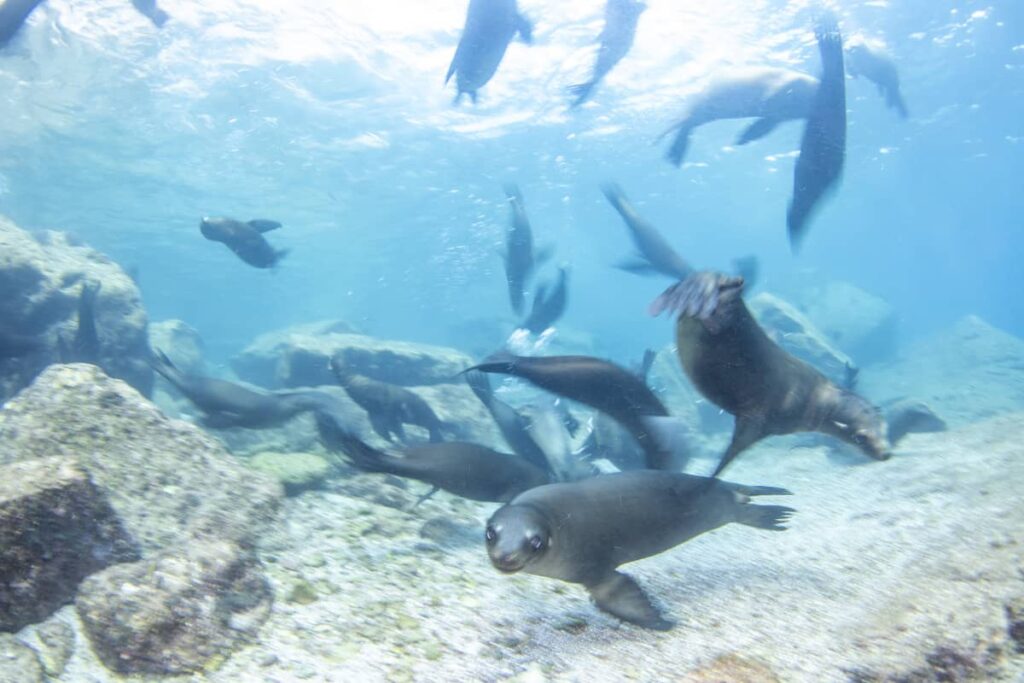
Top Dive Sites Around Darwin Island
Dive into Darwin Island’s underwater wonderland with these expanded, verifiable details about its legendary sites—each offering a unique blend of adrenaline, biodiversity, and geological drama.
1. Darwin’s Pillars (Formerly Darwin’s Arch)
Depth: 10–30 meters (33–100 ft)
Visibility: 15–30 meters (50–100 ft)
Currents: Strong, surging up to 3 knots
Highlights:
- Hammerhead Vortexes: Witness hundreds of scalloped hammerheads (Sphyrna lewini) schooling in mesmerizing spirals, often accompanied by Galapagos sharks (Carcharhinus galapagensis) and silky sharks (Carcharhinus falciformis).
- Whale Shark Highway: June–November, juvenile whale sharks (Rhincodon typus) glide near the surface, drawn by plankton-rich currents.
- Iconic Geology: Dive around the remnants of Darwin’s Arch, which collapsed in 2021. The site’s volcanic walls are adorned with black coral and sponges.
- Pelagic Spectacle: Encounter dolphins, eagle rays, and occasional orcas patrolling the drop-offs.
2. El Arenal
Depth: 15–40 meters (50–130 ft)
Visibility: 20–40 meters (65–130 ft)
Currents: Moderate to strong, with occasional downwellings
Highlights:
- Manta Ray Ballet: Year-round sightings of giant oceanic manta rays (Mobula birostris) with wingspans up to 7 meters, often accompanied by golden cownose rays.
- Shark Alley: Silky sharks (Carcharhinus falciformis) and Galapagos sharks patrol sandy slopes, while tiger sharks (Galeocerdo cuvier) appear seasonally.
- Volcanic Theater: Explore submerged lava formations and caves where green sea turtles (Chelonia mydas) and moray eels hide.
- Killer Whale Surprises: Rare but thrilling encounters with orcas (Orcinus orca) hunting tuna pods.
Unique Feature: The site’s gently sloping sandy bottom is a hotspot for macro life, including red-lipped batfish (Ogcocephalus darwini) and seahorses.
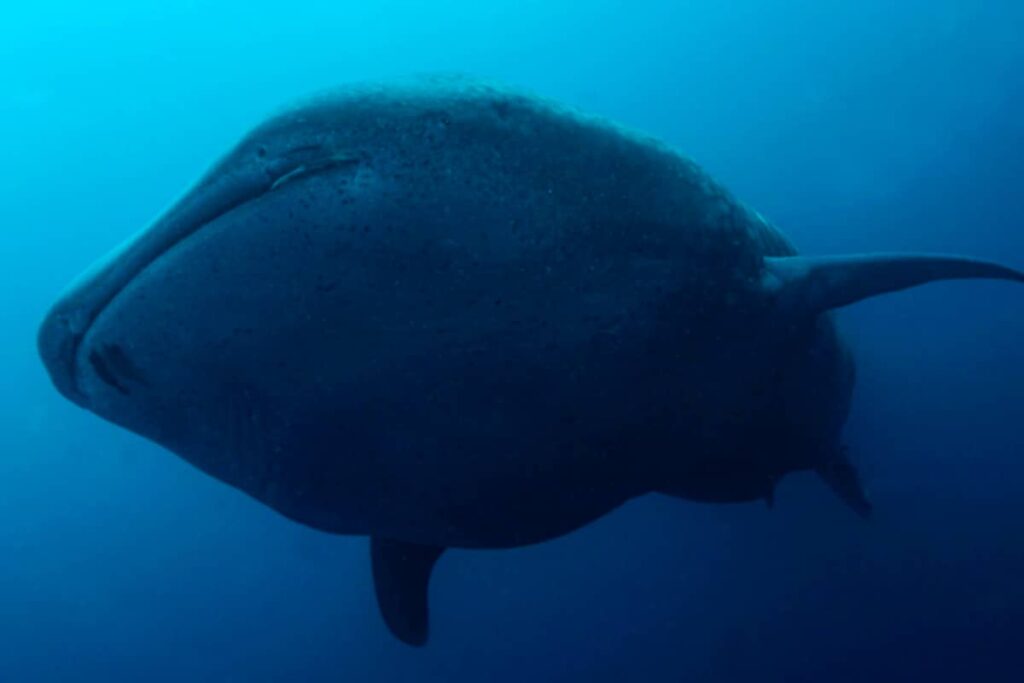
3. The Theater
Depth: 20–30 meters (65–100 ft)
Visibility: 10–25 meters (33–82 ft)
Currents: Unpredictable “washing machine” surges
Highlights:
- Fish Tornadoes: Drift through swirling schools of big-eye jacks (Caranx sexfasciatus), creolefish (Paranthias colonus), and bonito tuna, creating a silvery vortex.
- Shark Cleaning Stations: Watch white-tip reef sharks (Triaenodon obesus) and marble rays (Taeniurops meyeni) hover near volcanic outcrops for parasite removal.
- Mola Mola Cameos: Spot oceanic sunfish (Mola mola) during cooler months (July–December) as they bask in nutrient-rich upwellings.
- Geological Drama: Navigate through lava tunnels and overhangs covered in vibrant cup corals and orange basket sponges.
Diving Tips
- Certification: Advanced Open Water required for strong currents.
- Gear: 7mm wetsuit (and possibly a dry suit for cold sensitivity), hood, gloves, and booties for warmth. You'll also need a mask, snorkel, fins, dive computer, regulator, BCD (Buoyancy Control Device), reef hook, and nitrox and a surface marker buoy.
Many operators offer rental gear, but it's recommended to bring your own mask, fins, gloves, booties, hood, and dive computer if possible, especially for comfort and fit .
Travel Tips
- Permits: Secure through licensed operators; includes $200 Galápagos National Park fee.
- Health: No vaccines required unless arriving from yellow fever zones; use DEET repellent in wet season. Pack seasickness meds—open-ocean crossings are rough.
- Clothing & Gear: Biodegradable sunscreen only; UPF 50+ rash guards and sturdy sandals recommended. See diving section for recommended diving gear.
- Money: Use USD (small bills for tips). Most ships accept cards, but connectivity is unreliable.
- Environmental Ethics: No single-use plastics—bring reusable bottles/straws. Stay 2m from wildlife (6m from sharks/whales); collecting natural items is illegal.
- Connectivity & Logistics: Expect limited Wi-Fi. Use soft-sided luggage (max 20kg) and refill provided drinking water.
Worth the Effort
Darwin Island is a living laboratory of evolution, where volcanic forces and marine abundance collide. From its hammerhead-filled waters to its pioneering conservation efforts, this remote frontier epitomizes the Galápagos’ untamed spirit. Ready to Dive In?


